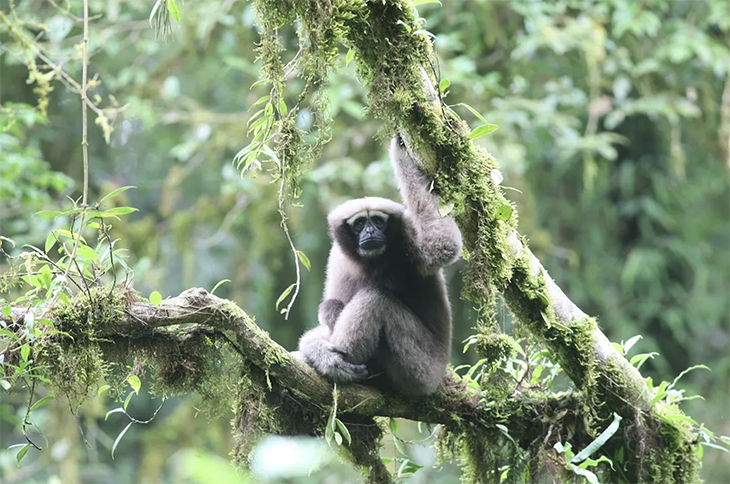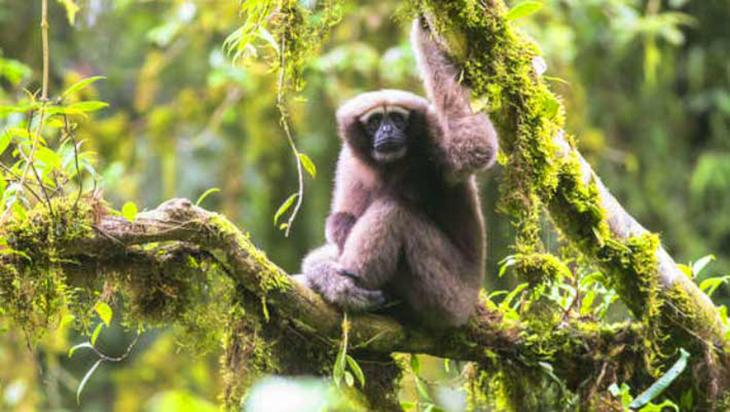
Exciting developments in species conservation have emerged from the Far East, particularly in Myanmar, where new populations of the stunning ‘Skywalker’ gibbon have been discovered. This species, also known as the hoolock gibbon, was only identified by scientists six years ago, initially observed in the remote southern regions of China, specifically in the mountainous terrain of Yunnan. Despite its recent recognition, the Skywalker gibbon was already classified as Endangered by the International Union for Conservation of Nature (IUCN), with a meager estimated population of 150 individuals in China. However, there were indications that additional populations existed in Myanmar.
Myanmar, a nation fraught with political instability even before the recent upheaval caused by a military junta, presented significant challenges for exploration and conservation efforts. The ongoing conflicts between the central government in Yangon and various insurgent groups, notably in the Shan and Kachin states, further complicated access to these areas.
Despite these challenges, a team of courageous scientists from organizations such as the Nature Conservation Society Myanmar, Fauna & Flora International–Myanmar Programme, the IUCN’s ape specialist group, and researchers from universities across the globe ventured into these volatile regions. Their collaborative efforts included conducting acoustic surveys, employing non-invasive DNA sampling techniques, and capturing morphological data through photography. Additionally, they engaged with local communities residing in rural forested areas, as well as conservation initiatives and timber companies, to gather information on gibbon sightings and hunting pressures.
Previously, population estimates of the hoolock gibbons in Myanmar, conducted with varying degrees of accuracy and scientific rigor in 2013, suggested a population as high as 65,000 individuals. However, the situation became significantly more intricate with the recognition of the Skywalker gibbon as a distinct species from the eastern hoolock gibbon. This differentiation clarified previous confusion between the two species, underscoring the necessity for updated and precise population assessments to inform targeted conservation strategies.
In summary, the discovery of Skywalker gibbons in Myanmar marks a pivotal moment for species conservation efforts in the region. Despite the formidable challenges posed by political instability and armed conflict, the collaborative efforts of scientists and conservationists offer hope for the protection and preservation of these enchanting primates in their natural habitats.

“We were able to genetically identify 44 new groups of Skywalker gibbons in Myanmar,” senior author as well as contributing author of a research faculty at the UC Davis School of Veterinary Medicine, Tierra Smiley Evans, said. “This is a huge resource and success story for Myanmar.”
The enchanting dawn chorus of the gibbons reverberates for approximately 22 minutes, a harmonious exchange of melodies amidst the waking hours. These graceful creatures, with a palate as diverse as their songs, partake in the bounty of nature, consuming a remarkable array of 36 plant species. Their dietary preference, akin to a refined culinary art, starts with the succulent offerings of fruit, followed by the delicate allure of flowers.
Their nomadic habits, a dance with survival, dictate that they seldom rest under the same canopy two nights in succession, a strategic maneuver to evade the looming threat of predation. Hindered by their inability to traverse water bodies, they find themselves tethered to territories delineated by the meandering veins of river systems.
In the midst of China’s wilderness, a team of intrepid explorers stumbled upon these celestial beings in 2017, their hearts tethered to the cosmos by the threads of their love for Star Wars. Dubbed “tianxing” in homage to their discovery, the name resonates not only with the echoes of a beloved sci-fi saga but also with the annals of China’s ancient lore. Within the sacred pages of the Book of Change, penned in the illustrious era of the Zhou Dynasty, gibbons are immortalized, their movements encapsulated by the verb “tianxing.”
Interviews with the denizens of these verdant realms unveiled a trove of invaluable insights for the scientific community. Across the provinces of Kachin and Shan, the familiarity with Skywalker gibbons among the populace, both in sight and sound, lent credence to the reliability of the study that was made.
In the serene enclaves of Mae Nei Taung, nestled within the bosom of non-protected forest reserves, a tapestry of Buddhist beliefs interwove with observations of diminishing gibbon presence. Remarkably, amidst this tranquil backdrop, no tales of local gibbon hunting emerged, buoyed by the reverence enshrined in social taboos against such acts.
Yet, the narrative diverges in the villages encircling the Paung Laung forest reserve, where echoes of Christian and Buddhist traditions coalesce. Here, a stark contrast unfolds, as 46% of interviewed villagers disclosed the harrowing reality of gibbon hunting. Among those who voiced their perspectives on the waning gibbon population, an overwhelming 85% attributed the decline to the gradual erosion of local forest cover, a testament to the intricate dance between humanity and the natural world.
“Biologists did not believe Skywalker gibbons could live in the small remaining patches in Southern Shan State before we started this project,” Pyae Phyo Aung, executive director of Nature Conservation Society Myanmar, said when speaking to the UC Davis press.
“I am delighted with our field team members who have done an excellent job, within a short period of time, building community trust for further conservation actions. This area is degraded forest. It is really important for Myanmar and China to consider extending conservation approaches for the Skywalker gibbon to this new geographic area.”
Approximately 32,000 square kilometers, equivalent to about 8 million acres, of forested land in Eastern Myanmar provide suitable habitat for gibbons. Despite the presence of expansive forest reserves such as Paung Taung and Mae Nei Laung, they lack adequate protection. Consequently, the survey team suggests maintaining the ‘Endangered’ status of gibbons on the IUCN Red List until measures to safeguard their habitat have already been enhanced.
What are your thoughts? Please comment below and share this news!
True Activist / Report a typo


